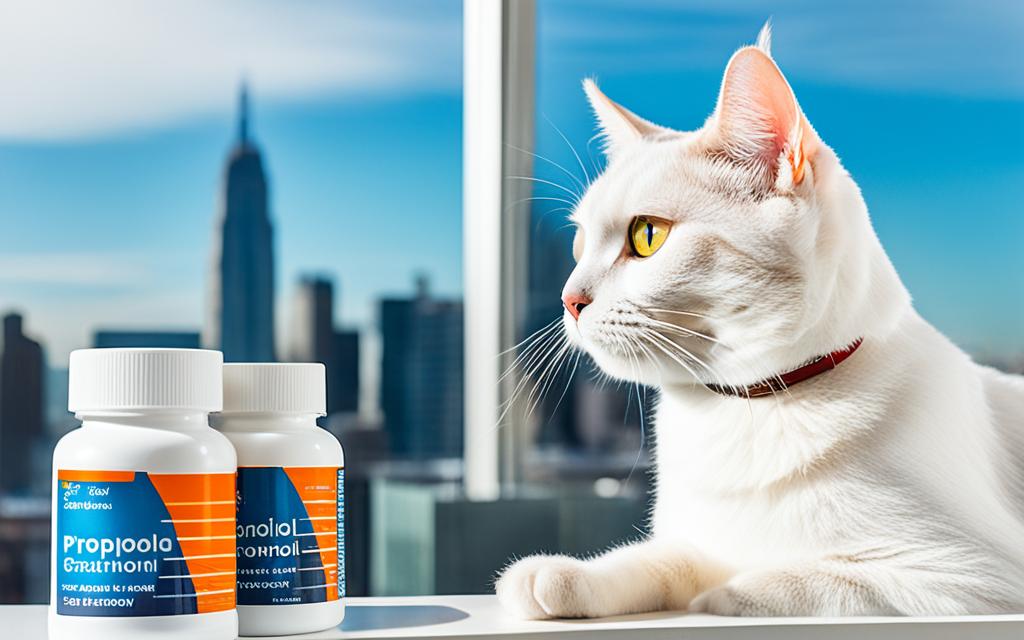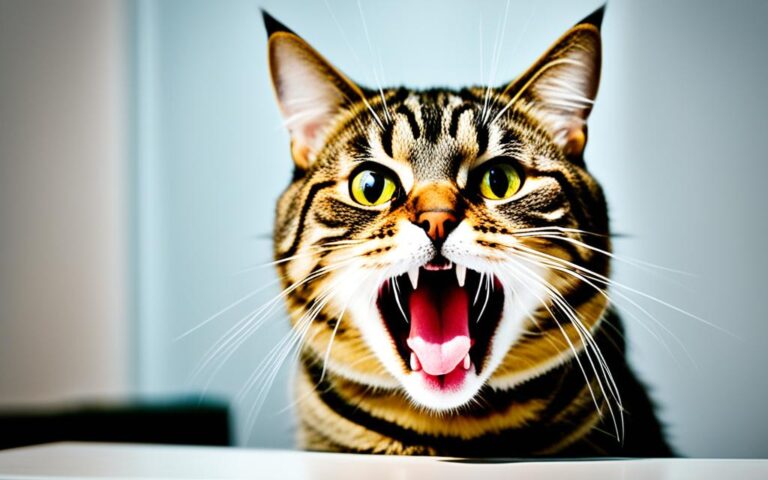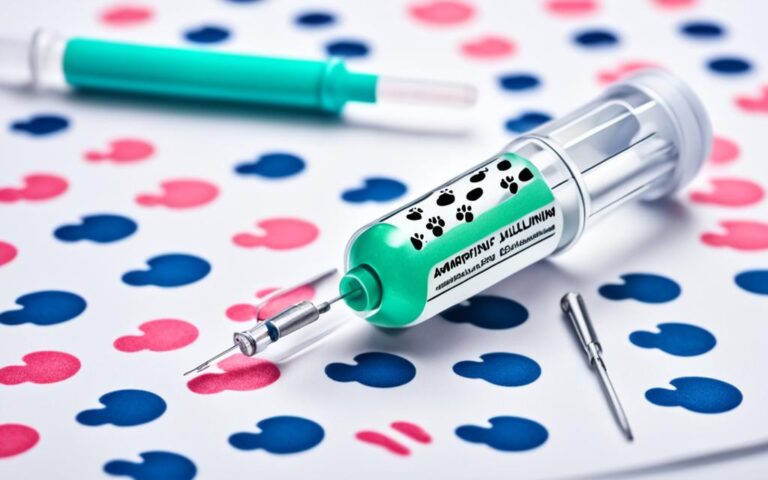Propranolol for cats: Uses and Effects
Did you know Propranolol is not just for people? It’s a common medicine given to cats for heart problems, high blood pressure, and even migraines1. Veterinarians use this drug to help their feline patients with heart issues and some neurological problems.
Propranolol comes under different brand names like Inderal®, Detensol®, Hemangeol®, and Innopran®. Vets may give it to cats with heart irregularities, high blood pressure, and similar conditions1. It helps by lessening the effects of certain body chemicals. This eases the heart’s work and lowers blood pressure.
Key Takeaways
- Propranolol is a beta-blocker medication used to treat heart conditions, high blood pressure, and migraines in cats.
- It can be prescribed for cats with abnormal heart rhythms, after a heart attack, and to prevent strokes and kidney problems.
- Propranolol works by blocking natural chemicals in the body, reducing heart rate, blood pressure, and strain on the heart.
- The dosage is determined based on the cat’s medical condition and response to treatment.
- Regular monitoring is necessary, especially for changes in blood pressure or symptoms.
Table of Contents
What is Propranolol?
Definition and Brand Names
Propranolol is prescribed for cats to treat many conditions2. It goes by brand names like Inderal®, Detensol®, Hemangeol®, and Innopran®. It’s also available in generic versions3. Although not FDA-approved for pets, vets can use it off-label in some cases2.
Mechanism of Action
This medicine is a type of beta-blocker. It stops the heart and blood vessels from reacting to certain things2. This calming effect can slow a fast heart rate and lower blood pressure2.
Vets might use Propranolol for quick fixes in cats and dogs with specific issues2. But, it works less well than other similar medicines, so pets might need it more often2.
In cats and dogs, Propranolol is given to help with heart rhythms, high blood pressure, and some heart troubles4. It does this by blocking adrenaline’s effects, which then lowers their blood pressure4.
“Propranolol should not be used in pets with specific medical conditions such as heart failure, certain heart arrhythmias, and respiratory conditions.”2
Vets should be careful using it in pets with kidney or liver problems, plus diabetes. They might need to change the dose slowly to be safe2.
Propranolol for Cats: Uses and Indications
Propranolol, a beta-blocker medication, is key in treating many heart and blood issues in cats5. It helps control abnormal heart rhythms and high blood pressure. Also, it manages a rare heart problem called Tetralogy of Fallot in cats6. For cats with hyperthyroidism, it’s used short-term to handle high heart rate and blood pressure too7.
Though the FDA hasn’t officially okayed propranolol’s use in animals, vets can use it for these health needs6. It works by stopping adrenaline from affecting the cat’s heart and blood pressure6. This effect is useful in dealing with various heart issues in our feline friends.
| Condition | Propranolol Use | Dosage Range |
|---|---|---|
| Arrhythmias | Regulate heart rhythm | 0.5 to 1 mg/kg PO q8h7 |
| Hypertension | Lower blood pressure | 0.5 to 1 mg/kg PO q8h7 |
| Tetralogy of Fallot | Manage congenital heart condition | 2.5 to 5 mg PO q8h7 |
| Hyperthyroidism | Control heart rate and blood pressure | 2.5 to 5 mg PO q8h7 |
Propranolol is very helpful for cats with heart issues6. It’s good at adjusting heart rate and blood pressure. If your vet prescribes it, they’ll guide you on the right use to keep your cat healthy.

In short, propranolol in cats treats problems like irregular heartbeats and high blood pressure. It can also help with a rare heart condition and short-term issues like in hyperthyroidism576.
Administering Propranolol to Cats
Propranolol is a common beta-blocker used to treat heart issues in cats. Giving it correctly is vital for your cat’s health. We will look at the right dosage and what to do if a dose is missed.
Dosage and Directions
Propranolol comes as tablets, capsules, or liquids for your cat to swallow. Your vet will decide how much and often to give it. They look at your cat’s health and how they react to the drug8.
For most cats, the usual dose is 2.5 to 5 mg every 8-12 hours by mouth. This helps with heart issues like myocardial infarction8. Always follow what your vet says about giving propranolol to your cat.
You can give propranolol with or without food, but giving it with food might lessen stomach issues8. What’s key is to give the medicine at the same time every day. This keeps the drug at a steady level in your cat’s body.
Missed Dose Guidelines
Missing a dose happens. But, talk to your vet if you skip one. Normally, you should give the dose if you remember it and it’s not close to the next dose8. If it’s almost time for the next dose, just skip the one you missed.
Don’t try to make up for the missed dose. This could hurt your cat. Following the dosing plan just as the vet said is very important. If you’re not sure what to do, ask your vet for advice.
“Consistent and timely administration of propranolol is key to ensuring the best possible outcome for your feline friend.”
Potential Side Effects and Precautions
Propranolol can help cats but watch out for side effects and take care9. It might cause issues in older pets or those with heart problems getting worse9. They could feel tired, have diarrhea, or face more severe problems like a slow heart rate9. Watch for signs of heart failure, low blood pressure, sugar, or closed off airways9.
Be careful with Propranolol if your cat has certain health issues9. Don’t use if your cat is allergic or has serious heart or asthma conditions9. It’s also risky for cats with kidney or liver problems, diabetes, too much thyroid activity, or heart issues9. If you stop the medicine suddenly, that’s also a risk9.
Propranolol can mix badly with some drugs like those for heart or digestive issues, or pain9. Your vet might need to check your cat’s heart and blood often9.

Always do as your vet says with Propranolol and tell them of any problems fast91011.
| Precautions When Using Propranolol in Cats |
|---|
| Avoid use in cats with heart block, overt heart failure, asthma, or slow heart rate Use cautiously in cats with kidney disease, liver disease, diabetes, hyperthyroidism, or abnormal heart sinus node function Do not abruptly stop propranolol as it may increase the risk of side effects Monitor the cat’s ECG and blood pressure while using propranolol Watch for potential interactions with other medications |
Know the risks and how to limit them. Propranolol can be a good tool in a vet’s kit91011.
Drug Interactions and Monitoring
When giving a cat propranolol, watch out for drug interactions and monitor the cat closely12. Some other medicines, when taken with propranolol, might be risky for the cat’s health13. Vets should be careful and make sure they don’t give propranolol along with drugs that could harm the cat.
Medications to Avoid
Cats on propranolol should not take certain drugs. These include many different types such as alpha-2 agonists, amiodarone, and more1314. Mixing these with propranolol can cause some serious health problems for the cat.
Monitoring Requirements
Cats using propranolol need to be checked often by a vet13. This means having their heart’s electrical activity and blood pressure checked regularly12. Vets might also suggest more visits to make sure the medication is working right and not causing any harm.
Vets can keep cats safe on propranolol by knowing what drugs to avoid and how to monitor them well121314. This careful approach helps ensure propranolol helps the cat without causing any harm.
Propranolol Compared to Similar Drugs
There are several heart medications for cats besides propranolol15. When deciding between them, pet owners and vets should think about their unique qualities.
Propranolol doesn’t get absorbed into the body as well as some others16. Because of this, it doesn’t last long in the body. This means it needs to be given more times a day. But, other drugs might work for a longer time, so you wouldn’t have to give them as often16.
Research has found propranolol to be better than a drug called ICI 66082 at stopping a certain hormone called renin15. It showed that the more propranolol was used, the better it worked. ICI 66082 didn’t show this kind of pattern15.
In stopping the release of renin by nerves, propranolol was nearly 6 times more effective than ICI 6608215. This means for certain conditions in cats, propranolol could be better at reaching treatment goals.
Sometimes, a vet might choose a different drug for a cat’s heart problem. They consider things like cost, side effects, and how well it works17. It’s important to fully understand how propranolol differs from similar medications when treating a cat16.
| Medication | Dose-Response Relationship in Inhibiting Renin Release | Effectiveness in Blocking Renin Release Triggered by Nerve Stimulation |
|---|---|---|
| Propranolol | Demonstrated a clear dose-response relationship15 | Approximately 5.55 times more effective than ICI 6608215 |
| ICI 66082 | Did not exhibit the same level of dose-dependent effects15 | Approximately 5.55 times less effective than propranolol15 |
In conclusion, while propranolol is often used for cat heart issues, it might not always be the top pick. Vets need to closely look at propranolol’s features against other drugs. This helps choose what’s best for each cat171516.
Storage and Safety Measures
It’s vital to store and handle propranolol for cats safely. Propranolol Hydrochloride Tablets are marked as Category 4 for Acute Oral Toxicity under GHS rules. They are also tagged as Reproductive Toxicity Category 2 under GHS and affect reproduction harmfully as Category 3 in the EU. Important safety measures include always washing hands after use and never eating, drinking, or smoking when handling the medicine. Wear protective gear as needed.
Proper Storage Conditions
Keep propranolol at a room temperature of 59°F to 86°F (15°C to 30°C). It must be shielded from freezing, high heat, moisture, and light. Ensure the container is sealed tight. For compounded forms, follow the compounding pharmacy’s advice carefully.
Emergency Procedures
For an overdose or bad reaction, reach out to a vet or emergency animal care. Signs of too much propranolol include sickness, very weak heartbeat, feeling faint, or breathing problems. These are serious and need quick veterinary help.
If your cat eats Propranolol, rinse the mouth and head straight to a doctor. Follow storage guidelines on the medicine’s packing. It’s essential since it’s a drug.
| Chemical Properties | Values |
|---|---|
| Chemical name | Propranolol hydrochloride18 |
| Formula | C16 H22 Cl N O218 |
| Molecular weight | 295.8 g/mol18 |
| Classification (Regulation (EC) No 1272/2008) | Acute toxicity – Oral: Category 4 (H302) Reproductive toxicity: Category 1B (H360) Specific target organ toxicity – repeated exposure: Category 1 (H372) Acute aquatic toxicity: Category 1 (H400) Chronic aquatic toxicity: Category 2 (H411) |
| Oral LD50 | 466 mg/kg18 |
For fires with propranolol, use CO2, extinguishing powder, foam, or water. In a fire, it releases poisonous fumes like carbon monoxide. This can be very dangerous.
Propranolol for Cats: Key Drug Information
Propranolol is a medication used in cats for heart rhythms, high blood pressure, and a special heart issue called right-to-left shunts19. It works by slowing down the heart and lowering blood pressure. Even though they are not approved for animals, vets can prescribe it for cats19.
Vets often give propranolol to cats two or three times daily19. It’s important to store it in a sealed container at room temperature. This medicine helps with many heart problems like fast heartbeats and heart disease19.
Most cats do well on propranolol, but there might be side effects. These could be problems with the heart, low blood sugar, trouble breathing, and more. Vets need to watch closely which cats get this drug, to avoid bad reactions19. Interaction with other drugs is also possible, so careful monitoring is crucial19.
This drug is common in treating heart issues in pets like cats and dogs20. Usually, it’s given by mouth once or twice a day, depending on how sick the animal is20. Keep the tablets in a cool, dry spot to keep them working right20.
Using human heart drugs like propranolol in pets can be very risky, especially near older people. Too much of this drug can harm the pet’s health21. It’s vital for a vet to oversee the use of propranolol in cats. This ensures the pet stays safe and healthy while being treated.
| Key Information About Propranolol for Cats |
|---|
| Propranolol is a beta-blocker medication used off-label in cats for the management of cardiac arrhythmias, high blood pressure, and right-to-left shunts. Typical dosing for cats is two to three times daily. Proper storage requires a sealed container at room temperature (15°-30°C or 59°-86°F). Propranolol can be used in cats for conditions like sinus tachycardia, atrial fibrillation, supraventricular tachycardia, and more. Potential side effects in cats include bradycardia, heart failure, syncope, and others. Propranolol should not be used in cats with bradyarrhythmias, heart failure, or asthma. Drug interactions can occur with various medications, requiring close veterinary monitoring. Propranolol is widely used in veterinary medicine for managing cardiovascular conditions in cats and dogs. Careful storage and administration is crucial, as human cardiac medications can be dangerous for pets. |
Propranolol is key in managing many heart issues in cats. It’s safe when used properly but needs careful oversight by a vet. This ensures the health and safety of the cat receiving the treatment.
Conclusion
Propranolol is a key medicine for treating heart problems in cats. It works for issues like irregular heartbeats, high blood pressure, and a rare heart condition called hypertrophic cardiomyopathy22. The medicine affects the heart’s receptors, helping it beat more normally and lowering risks22.
However, giving propranolol to cats needs careful watch and understanding the side effects and interactions it might cause23. Vets might suggest different treatments for issues like overactive thyroids, including surgery, some medications, or using a mix of methods23. It’s key because male and female cats can react to propranolol in various ways, needing personal dosages24.
Owners who know about propranolol can help their cats get the right care. Working closely with vets ensures the best treatment for heart issues222324. This teamwork is vital for a cat’s well-being and quality of life when using propranolol.
FAQ
What is Propranolol?
How does Propranolol work?
What are the uses of Propranolol in cats?
How is Propranolol administered to cats?
What happens if I miss a dose of Propranolol for my cat?
What are the potential side effects of Propranolol in cats?
What medications should be used with caution when giving Propranolol to cats?
How is Propranolol different from other similar heart medications in cats?
How should Propranolol be stored for cats?
What should I do if I suspect an overdose or adverse reaction to Propranolol in my cat?
Source Links
- Propranolol Tablet for Dogs & Cats, 10-mg, 100 Tablets
- Propranolol for Dogs and Cats
- Propranolol (Inderal®, Intensol®) for Dogs and Cats
- Propranolol HCl (Generic)
- Antiarrhythmics for Use in Animals – Antiarrhythmics for Use in Animals – Merck Veterinary Manual
- Propranolol | Texas West Animal Health
- Propranolol – an overview | ScienceDirect Topics
- Management of Feline Cardiomyopathies – WALTHAMOSU2002
- Propranolol | VCA Animal Hospitals
- Uses, Dosage & Side Effects
- Propranolol medication guide
- Top Ten Potential Drug Interactions in Dogs and Cats – WSAVA2008
- Top ten drug interactions in dogs and cats (Proceedings)
- Pharmacokinetics of propranolol in the cat and comparisons with humans and three other species
- Propranolol – an overview | ScienceDirect Topics
- Pet Factsheets – Crossriggs Veterinary Clinic
- Propranolol Tablets 40mg, 100 Count
- The top 3 human medications pets ingest in 2019
- Effect of propranolol on the relationship between atrial systolic pressure and type A atrial receptor discharge in cats – PubMed
- The options for treating feline hyperthyroidism
- Effects of oral propranolol on the resistive and pulsatility indices of major abdominal vasculatures in domestic short‐haired cats







